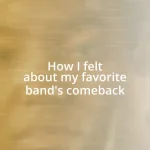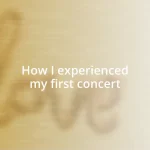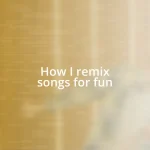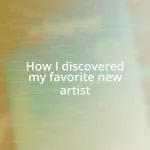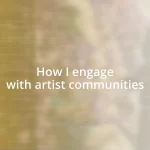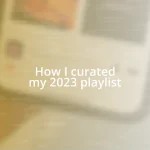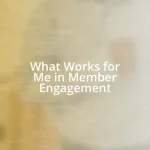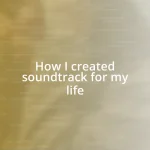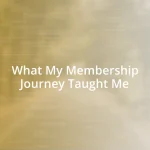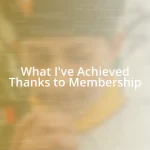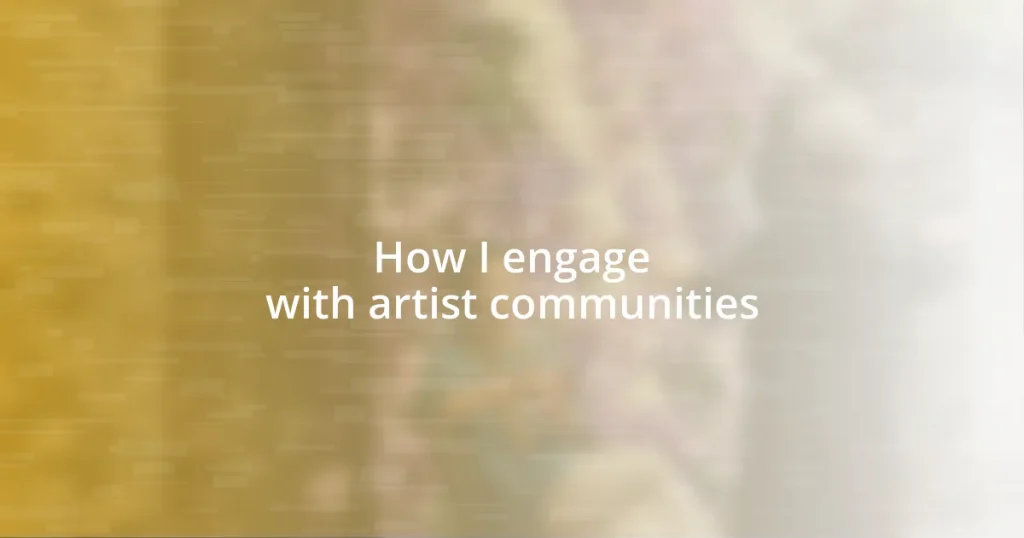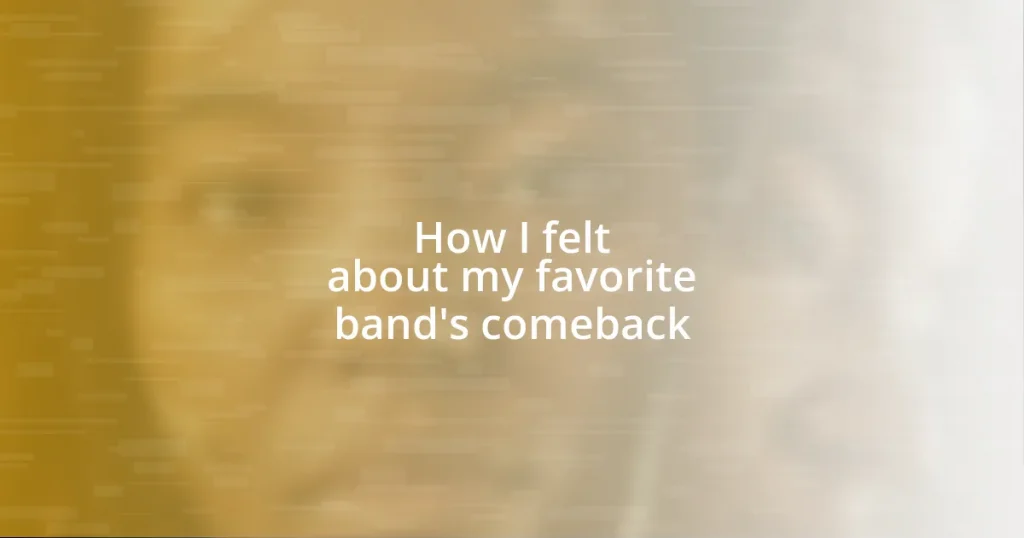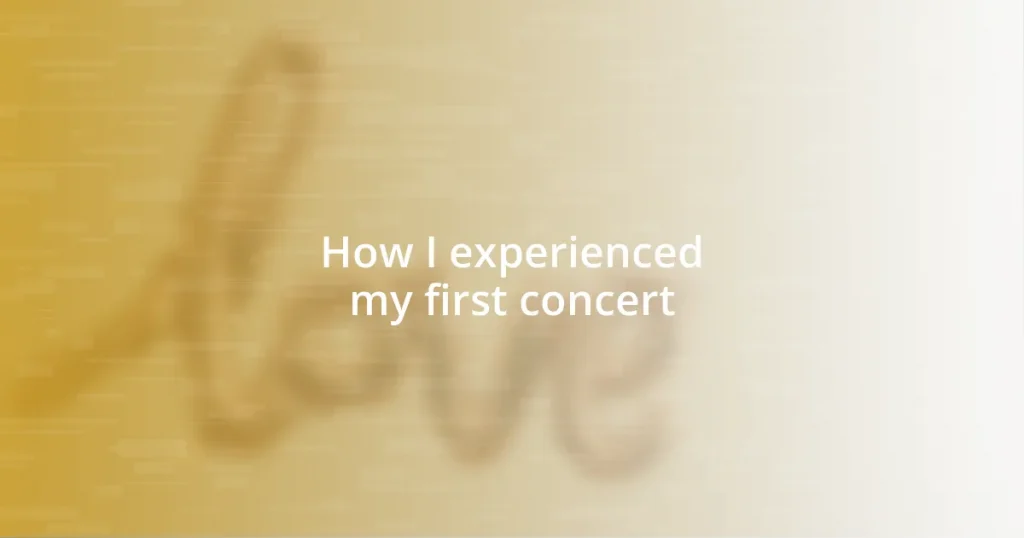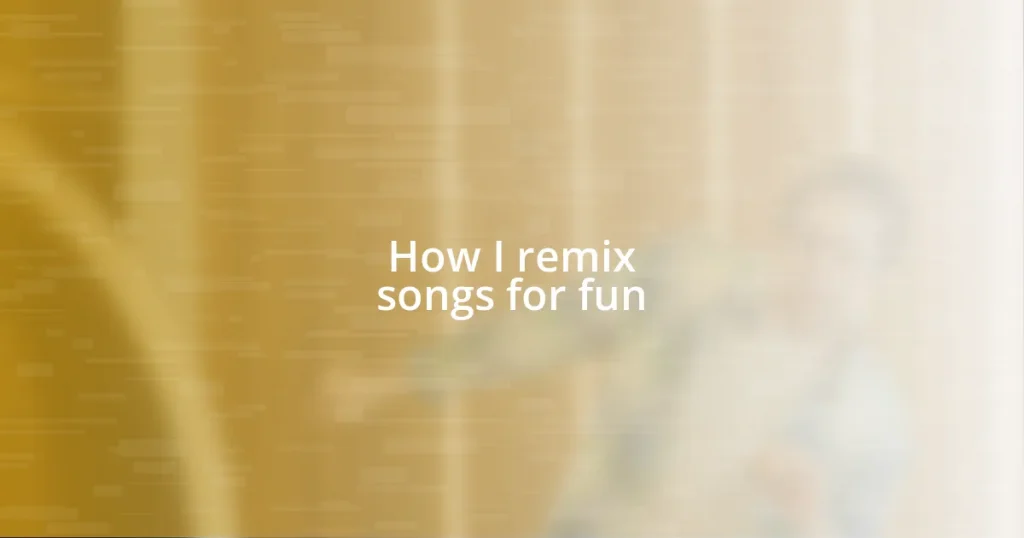Key takeaways:
- Artist communities foster collaboration and individual expression, leading to personal growth and connection.
- Identifying the right platforms, such as Instagram, Behance, and Facebook groups, enhances engagement with fellow artists.
- Building meaningful relationships is essential; attending events and participating in workshops can deepen connections.
- Providing and receiving constructive feedback creates a supportive environment that helps artists flourish and grow.
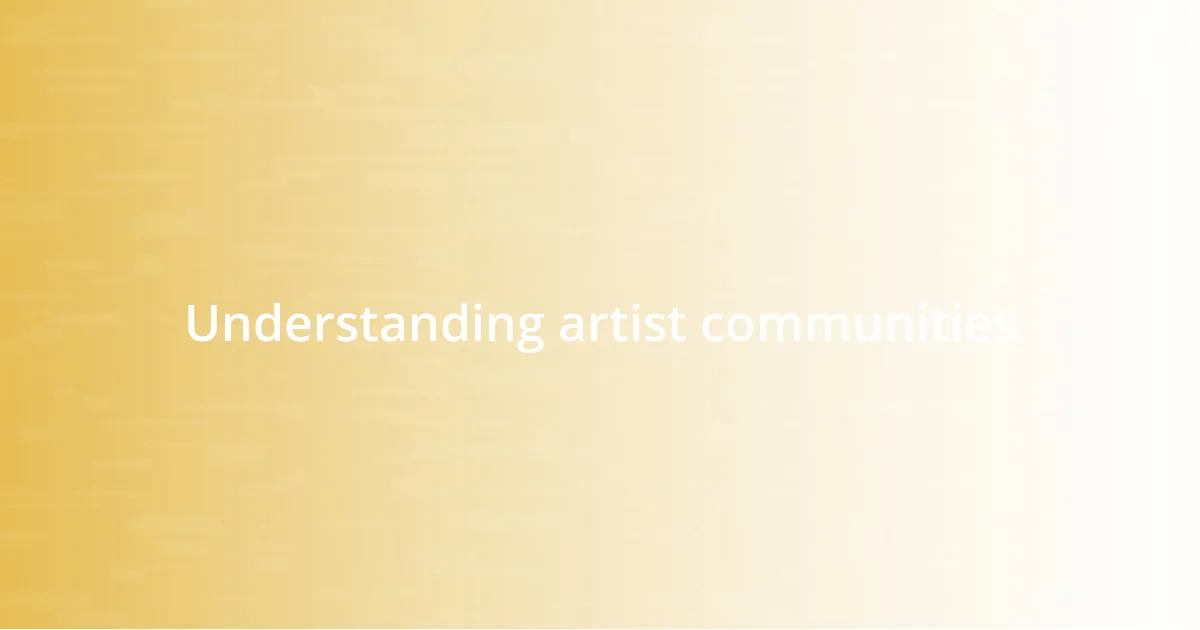
Understanding artist communities
Artist communities are fascinating ecosystems where creativity thrives and connection flourishes. I remember my first encounter with a local art collective; it felt like stepping into a vibrant tapestry of ideas, each thread representing a unique artist’s journey. Can you imagine being surrounded by people who share your passion, discussing techniques and inspirations? It’s energizing!
In these communities, collaboration often takes center stage. For instance, when I participated in a collaborative exhibition, it was incredible to see how our diverse styles melded into a cohesive narrative. It made me realize how artist communities not only encourage individual expression but also amplify our collective voices. How often do we miss opportunities to grow just because we stay in our comfort zones?
Understanding the dynamics of these communities also brings awareness to the support systems in place. When someone shares their struggles, it creates a safe space for vulnerability and growth. I often find that the biggest breakthroughs stem from open conversations with fellow artists who understand the hurdles in our creative paths. Isn’t it comforting to know there are others who resonate with the same challenges we face?
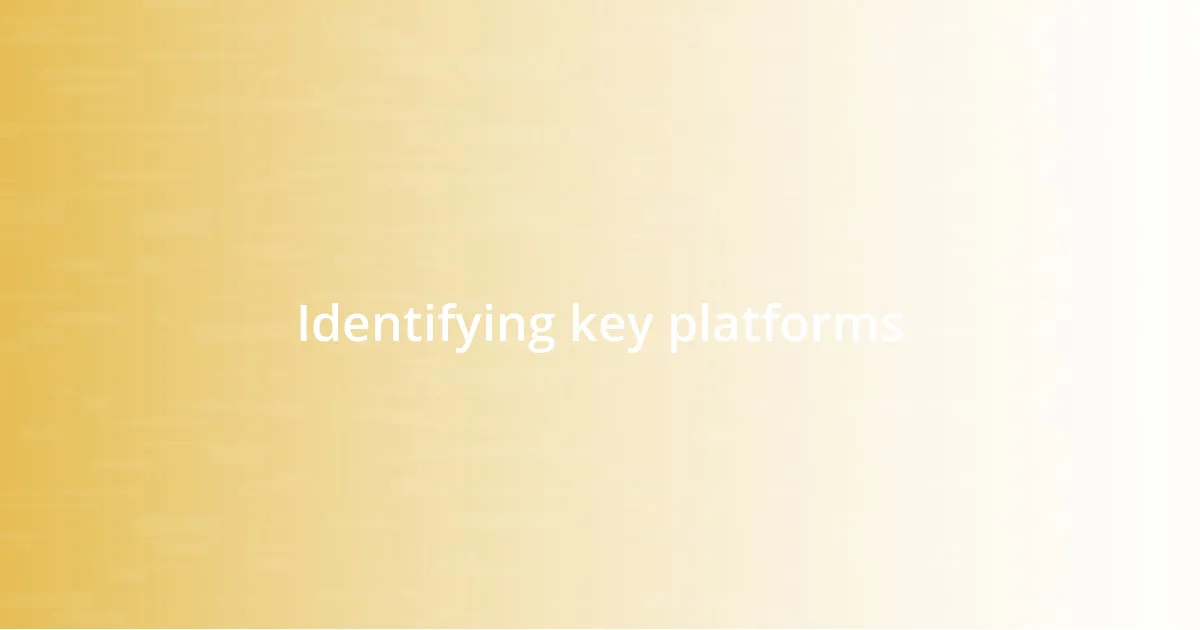
Identifying key platforms
Identifying the right platforms to engage with artist communities is essential for fostering connections. I’ve found that each platform offers unique opportunities tailored to different artistic voices. For example, social media sites like Instagram are fantastic for sharing visual work and gaining immediate feedback from a wide audience. In contrast, platforms like Behance focus on showcasing portfolios, which can lead to professional opportunities and collaborations.
When I first turned to Facebook groups dedicated to artists, I was pleasantly surprised by the warmth and support of the community. Conversations flowed freely, and each comment was a window into a different artist’s thoughts and experiences. It was here that I learned about opportunities to showcase my work and participated in online challenges that pushed my skills. Have you considered what a treasure trove of resources these dedicated groups can be?
To provide a clearer picture, here’s a comparison of some popular platforms used to engage with artist communities:
| Platform | Strength |
|---|---|
| Visual sharing, broad audience engagement | |
| Behance | Professional portfolio showcasing, collaboration opportunities |
| Facebook Groups | Supportive community discussions, resource sharing |
| DeviantArt | Dedicated artist platform, diverse art styles |
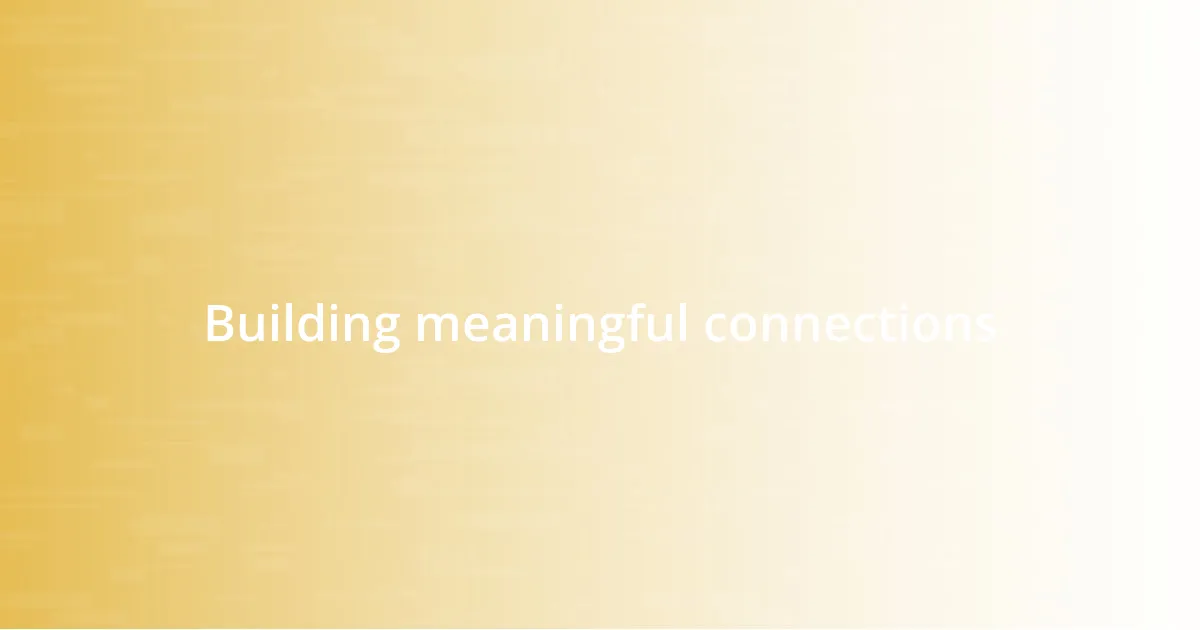
Building meaningful connections
Building meaningful connections in artist communities is about genuine interaction. I remember a powerful moment at a local art fair. I struck up a conversation with a fellow painter whose work was inspired by nature, just like mine. As we shared our stories, what stood out wasn’t just our common interests but the encouragement we found in each other’s struggles. It’s those conversations that have led me to lifelong friendships and collaborations that I never expected.
Here are some ways I focus on building those connections:
- Attend local art events and engage with artists face-to-face.
- Join creative workshops to learn and connect with like-minded individuals.
- Participate in collaborative projects that require teamwork.
- Follow up with artists I meet, sharing insights or simply checking in.
- Create opportunities for open dialogue, like artist meetups or forums.
Every interaction becomes a building block toward a richer community experience. With each connection made, I feel more inspired to create and share my art.
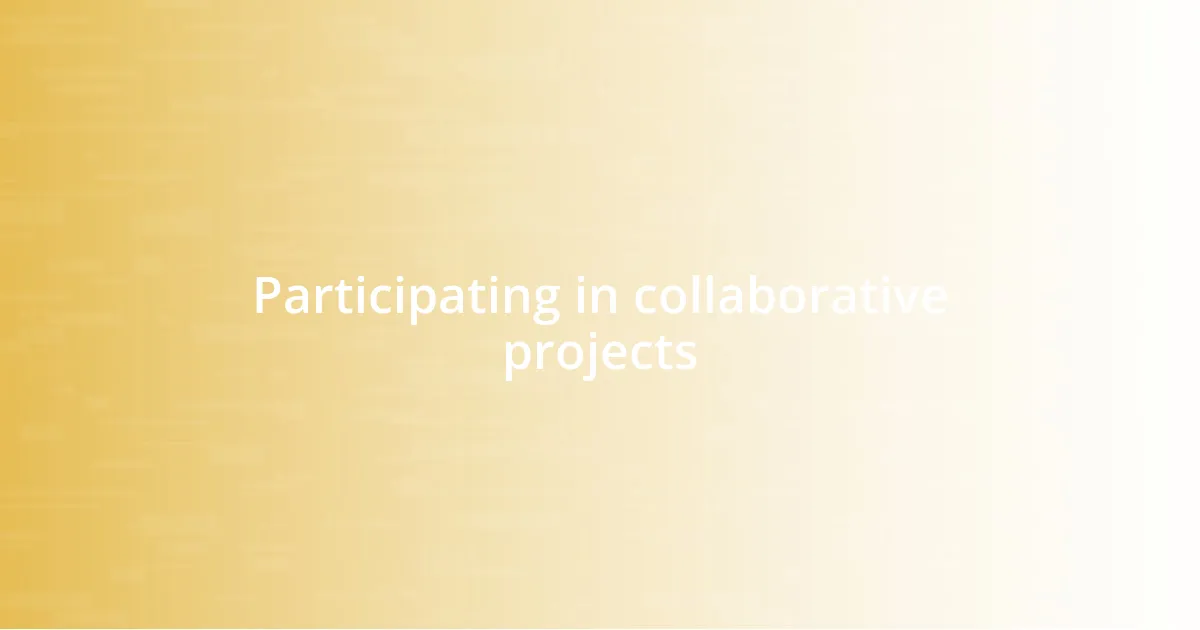
Participating in collaborative projects
Participating in collaborative projects within artist communities has always excited me. I recall one project where several artists combined their talents to create a mural for a local school. The experience was nothing short of transformative; it was thrilling to witness how our varying styles blended harmoniously, each brushstroke telling a piece of our individual stories. Have you ever experienced the magic that comes from collaborative creation? It’s a unique feeling that can elevate your artistry while deepening community bonds.
Moreover, I learned how collaboration can push one’s creativity. During a joint art installation, I was initially unsure about my contributions, feeling overwhelmed by the talent around me. But as we worked side by side, exchanging ideas, I found that my voice mattered just as much as theirs. It was enlightening to realize that vulnerability can lead to profound artistic growth. Engaging in these projects isn’t merely about the final product; it’s also about the journey and the connections forged along the way.
In my experience, collaborative projects also serve as a lens for viewing different perspectives. I remember discussing techniques with a sculptor who approached art in a way I had never considered. By combining our skills, we not only broadened our artistic horizons but enriched the project with diverse ideas. Isn’t it fascinating how stepping out of your comfort zone can lead to unexpected insights? Participating in these collaborative endeavors continually reminds me of the boundless possibilities that arise when artists unite.
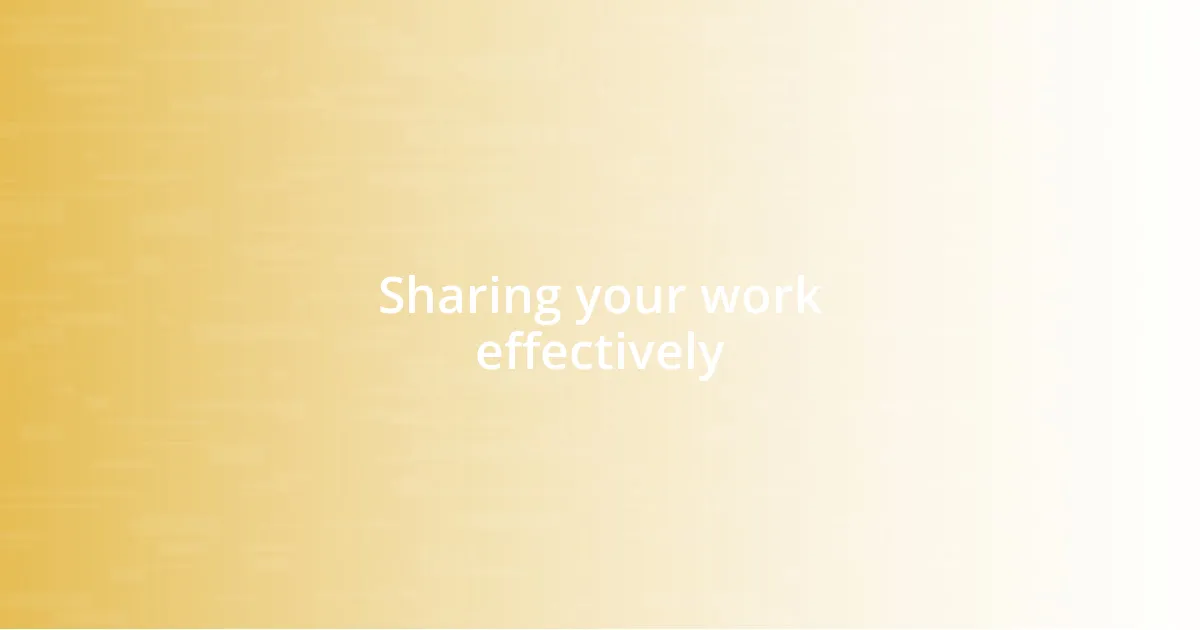
Sharing your work effectively
Sharing your work in artist communities is more than just showcasing what you create; it’s about telling a story that resonates with others. A few months ago, I decided to present my latest series at a local gallery night. I made sure to share not just the pieces but the emotions and thoughts that went into them. I often ask myself, how can I turn a viewer’s initial glance into a deeper connection? By inviting conversations and revealing the inspiration behind my work, I’ve seen eyes light up with understanding – it’s those moments that truly make sharing worthwhile.
I also find that utilizing social media platforms effectively can be a game-changer. When I first started sharing my art online, I focused solely on aesthetics, but I quickly learned that storytelling elevates engagement. For instance, I posted a video of my process while creating a large canvas, narrating the highs and lows I encountered. It sparked an influx of comments and messages, allowing me to connect with others who shared similar experiences. Have you ever thought about how revealing your behind-the-scenes life could transform your online presence? Sharing these insights not only draws people in but fosters a sense of community among fellow artists and admirers.
Moreover, I make it a point to respond to feedback and engage with those who appreciate my work. One time, an art student reached out to me about a piece that deeply resonated with her. I took the time to chat with her and share tips based on my journey. This simple interaction not only helped her grow but also enriched my own experience as an artist. It’s moments like these that reinforce my belief—sharing your work effectively involves creating dialogue that invites others into your artistic world. What if we all committed to fostering these connections? imagine the depth of our communities!
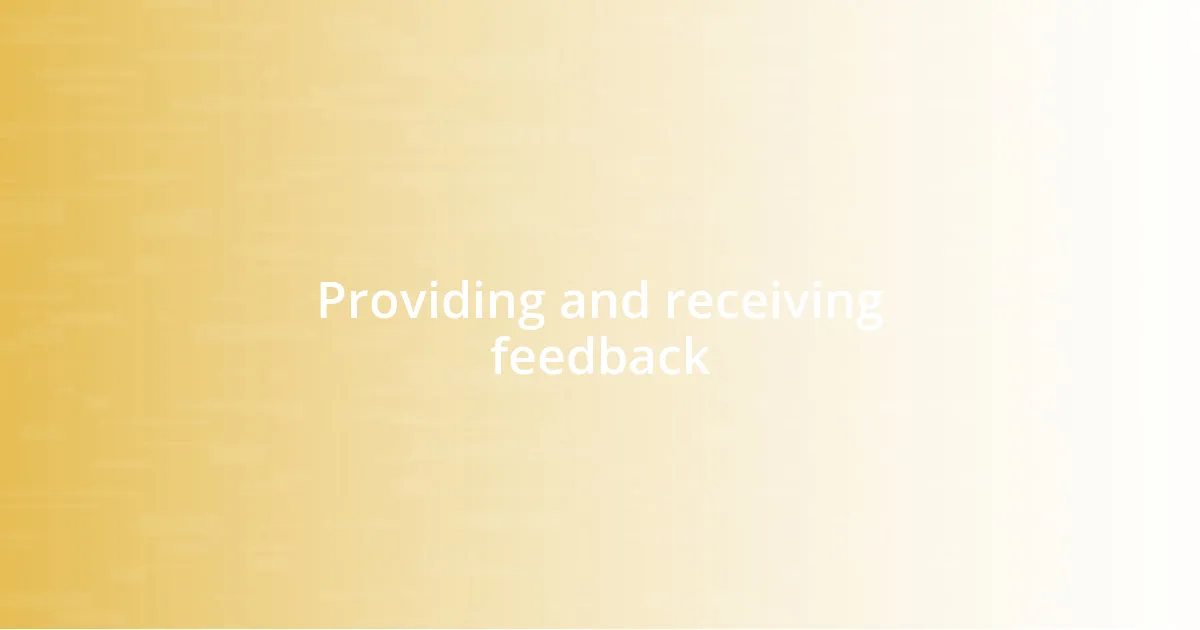
Providing and receiving feedback
Providing constructive feedback is an essential part of artist communities. I remember a time when I shared a piece I was really proud of, only to receive criticism that initially stung. However, diving deep into the comments, I realized there was a wealth of insight hidden within the critiques. Have you ever noticed how the most helpful feedback often requires us to swallow our pride? It’s a learning moment that can truly shape your work if approached with an open mind.
On the flip side, receiving feedback isn’t just about growth—it’s also about connection. Last year, I participated in an open critique session where artists exchanged views on each other’s work. I was struck by how vulnerable everyone felt yet how empowering it was to express vulnerabilities. It was a shared experience; we applauded strengths and gently nudged each other towards improvements. Don’t you think that creating a safe space for feedback makes artists flourish? I’ve found that fostering honesty creates a stronger bond within the community.
When I provide feedback, I aim to be specific and supportive. I recall providing input on a fellow artist’s project, highlighting not just what could be improved but also the elements I loved. It’s incredible how a few positive words can make someone feel seen and valued. Engaging in this way invites a reciprocal openness; when you show appreciation, you often receive the same kindness in return. How do you deliver feedback in your circles? Finding that balance can lead to richer conversations and deeper relationships in our creative communities.
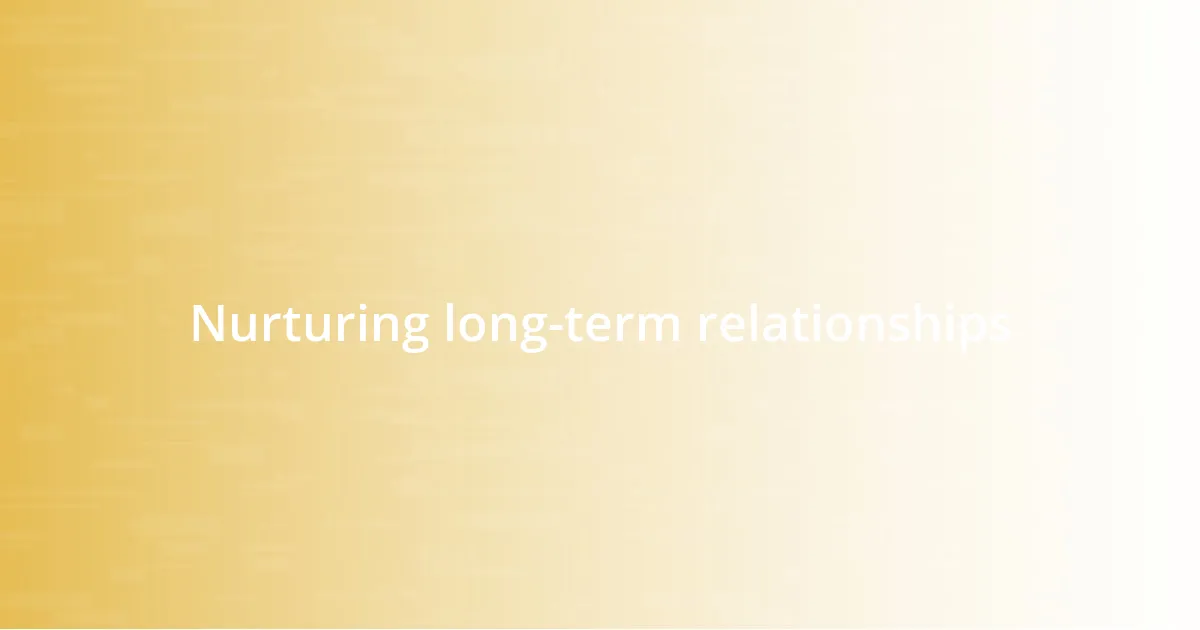
Nurturing long-term relationships
Nurturing long-term relationships within artist communities is all about consistency and authenticity. I still remember my first art workshop where I met a group of passionate creatives. Since then, we’ve formed a habit of checking in with one another. It may seem small, but those little messages asking about projects or simply sharing a funny meme can deepen connections over time. How often do you reach out to remind fellow artists that you’re thinking of them? Such gestures can transform acquaintances into lifelong friends.
A critical component of nurturing these relationships is mutual support. I recall a time when one of my painter friends was struggling with her latest series. I offered to host an informal feedback session at my studio, and we ended up spending an entire afternoon sharing ideas and sipping coffee. The relief and enthusiasm on her face when we wrapped up were priceless. Sometimes, offering your time can be the greatest gift. Isn’t it uplifting to realize that you can play a part in someone else’s creative breakthrough?
Additionally, attending community events regularly can strengthen bonds significantly. I frequently schedule gallery openings, art festivals, and even virtual meetings with my fellow artists. On one memorable occasion, I ran into an artist I hadn’t seen in months, and we instantly connected over our latest projects. Those spontaneous moments of joy remind me why nurturing these relationships is essential. Do you ever think about the unexpected connections that can arise when we foster our creativity together? It’s a beautiful reminder of the support system we build in our journeys as artists.
